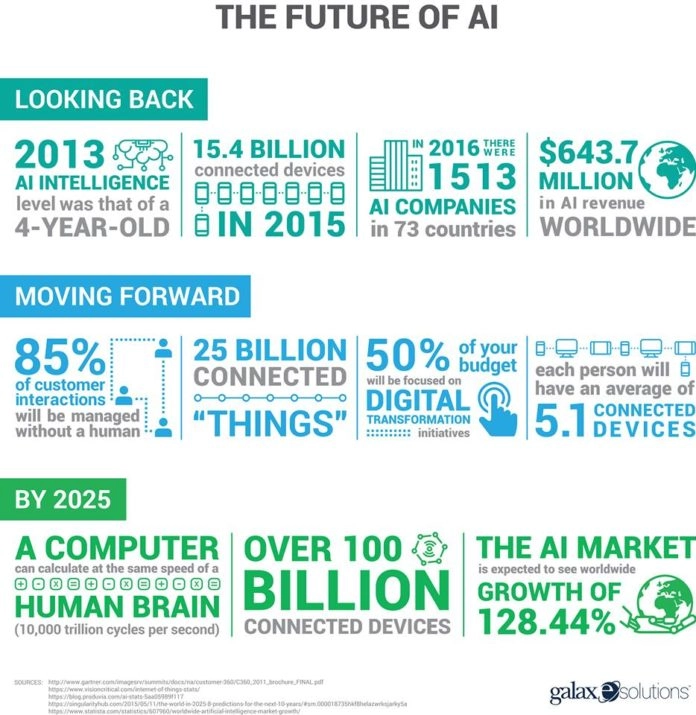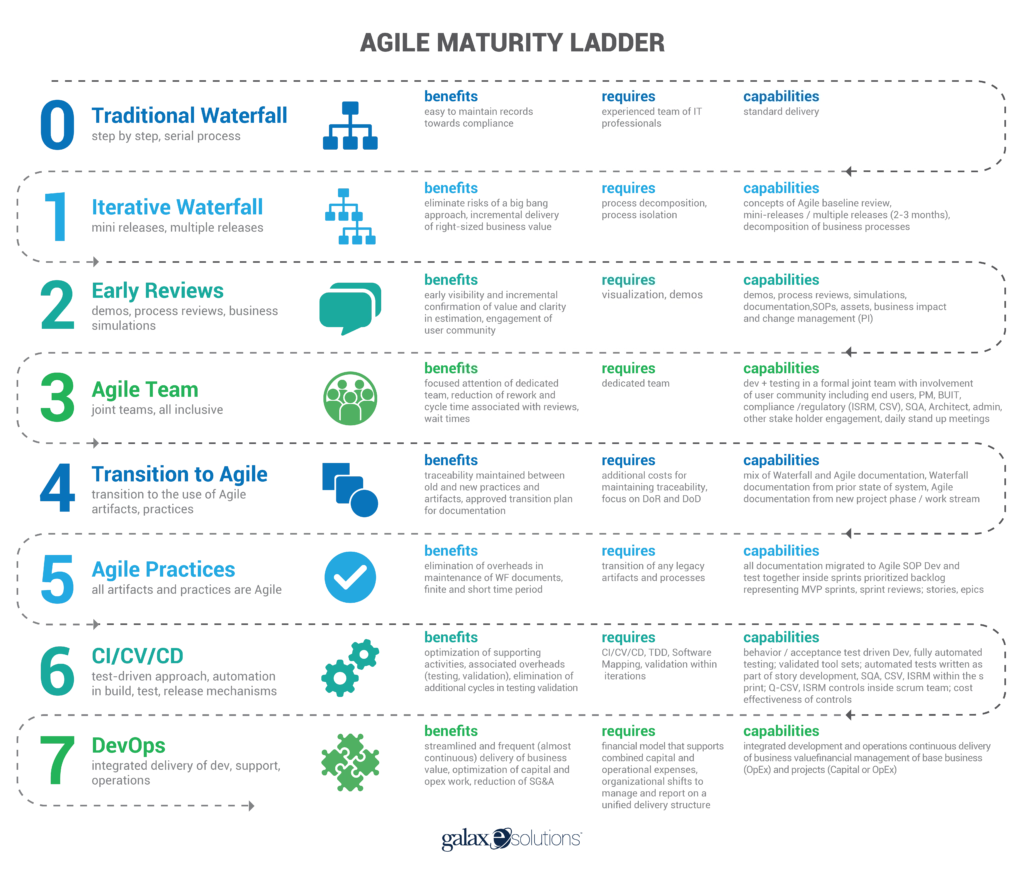Next Generation Brings New Technology
The quicker your team can launch a solution and test it in the real world, the sooner you will gain insight into how valuable – or not – it is. This focus on experimentation is what allows for quick pivots and successful product launches. Today’s younger generation demands a new approach – one that leverages technology to respond quickly to the needs of customers to create software that is more powerful and relevant. Let’s take a closer look at a few key important trends in the industry such as AI and Machine Learning, QA Automation, CI/CD, DevOps, and Blockchain Integration, and how these trends are steadily driving us toward a shared goal – faster and more transparent business.
Artificial Intelligence (AI) and Machine Learning (ML)
According to Dataversity, Artificial Intelligence and Machine Learning will be game-changers in the next decade. The website says the trend of creating connected and intelligent systems has already started and will gain further momentum in 2018. Going forward, they forecast 40 percent of digital transformation, and upwards of 70-80 percent of AI-powered, IoT initiatives will occur in 2019.
 According to the experts at Gartner, IDC, and Forrester, enterprises pursuing digital transformation initiatives will more than double the size of their software development teams by 2018, focusing their new hiring almost entirely on digital initiatives. They also predict that by 2020 nearly 50% of IT budgets will be tied to digital transformation initiatives. A lot of that focus will be on AI. CXO Today indicates that about 35 percent of advanced internet users prefer to use an AI advisor and about 25 percent hope to see an AI Manager next year.
According to the experts at Gartner, IDC, and Forrester, enterprises pursuing digital transformation initiatives will more than double the size of their software development teams by 2018, focusing their new hiring almost entirely on digital initiatives. They also predict that by 2020 nearly 50% of IT budgets will be tied to digital transformation initiatives. A lot of that focus will be on AI. CXO Today indicates that about 35 percent of advanced internet users prefer to use an AI advisor and about 25 percent hope to see an AI Manager next year.
CIO maintains that many organizations are actually using AI already, but they may not refer to it as AI. They note that enterprises have spent the past few years educating themselves on various AI frameworks and tools, but as AI goes mainstream, it will move beyond small-scale experiments to being automated and operationalized. Enterprises will increasingly look for products and tools to automate, manage, and streamline the entire machine learning and deep learning lifecycle. In short, they conclude that AI is already here, whether we recognize it or not. The need to develop a corporate AI strategy by the end of this decade will attain the same level of importance and urgency as developing a web strategy was at the end of the 1990s. And like web strategy, the first movers who get AI right are positioned for a winner-take-all scenario.
QA Automation
To fully utilize the first mover advantage, it makes sense for businesses to leverage their existing resources and subject matter expertise. Data-driven automation allows for QA and Development teams to stay one step ahead in the integration process and provide a more effective implementation. By establishing a customized framework for automated testing and tools, businesses will see increases in reliability and productivity, with a reduction in production errors. Quality will noticeably improve as well due to earlier defect detection in the software development cycle. For example, some of the automated regression suites allow testing of at least 90% of feasible scenarios. Forrester’s research has found that organizations which have adopted automation across the complete lifecycle, including continuous integration, continuous delivery, and production deployment, have experienced more velocity and quality. Purposeful end-to-end automation is essential for success, especially as DevOps initiatives scale. Forrester’s research shows the growing adoption of configuration management solutions and the move to complete automation of the CI/CD pipeline to enable rapid deployment of quality solutions. However, even with the current improvements, there continues to be significant opportunities for greater automation. IT departments will need to work closely with their DevOps partners to drive the adoption of more automation across processes and functions. GalaxE’s DevOps, CI/CD, and Agile Engineering enablement tools, GxMaps™, GxDash™, and GxQuality™, are a natural progression for QA automation that, once integrated, enhance redundancy, diversity, reliability, and fault tolerance. Integrating these solutions into your business is essential for efficient adaptation to shifting markets, regulation, and customer demands that
DevOps
An efficient process feedback loop can be the difference between success and failure. Good feedback loops inform teams what is or isn’t working with a particular product, or indicate what needs revision. By analyzing extensive data sets via automation, it’s possible to gather information very rapidly without hours of human labor. Standardized automation testing processes and tools provide roadmaps to a value-based delivery for DevOps transformation approaches. Closed-loop continuous integration also enhances agile delivery in regulated systems.
Analysts like Forrester are calling 2018 the “Year of Enterprise DevOps” and it’s not hard to see why. In its 2017 Q1 Global DevOps Benchmark Online Survey (based on the opinions of 237 DevOps professionals) Forrester indicates that 50% of the companies surveyed reported that they have already implemented DevOps, and are on the verge of expanding it further. Forrester reports that healthcare, banking, insurance, and manufacturing sectors are leading the way, while other industries are gradually picking up momentum. And according to Gartner, IT-related initiatives are the second highest business priority for CEOs (behind growth). In fact, IT was cited as a priority by 31% of CEOs, the highest percentage ever reported since Gartner began their survey. Businesses can benchmark their current DevOps maturity level by using the GalaxE Tiers of Maturity Model. GalaxE can then provide a roadmap to help them leap from whatever level they are currently to Tier 7, DevOps, in order to reach their full potential.
 As enterprises transition to DevOps, they will need to use metrics to understand progress and report success, as well as to point toward areas for improvement. For instance, reporting accelerated deployment velocity without an improvement in quality is not a success. Effective metrics are critical if a DevOps program is to drive intelligent automation decisions. Research identifies that many organizations are struggling with DevOps metrics. A good starting point includes metrics that align with velocity and throughput success.
As enterprises transition to DevOps, they will need to use metrics to understand progress and report success, as well as to point toward areas for improvement. For instance, reporting accelerated deployment velocity without an improvement in quality is not a success. Effective metrics are critical if a DevOps program is to drive intelligent automation decisions. Research identifies that many organizations are struggling with DevOps metrics. A good starting point includes metrics that align with velocity and throughput success.
Blockchain Integration
According to Forbes, a blockchain is a distributed database that maintains a growing list of ordered records, called blocks. Each block has a timestamp and a link to a previous block. The concept was introduced in 2008 by Satoshi Nakamoto and then implemented for the first time in 2009 as part of the digital Bitcoin currency. Blockchain takes the place of three crucial roles traditionally carried out by the financial services sector: recording transactions, establishing identity, and establishing contracts. The third role, establishing contracts, extends the usefulness of blockchain outside the financial services sector because a blockchain can be used to store any digital information, including computer code. That snippet of code could be used to create “smart contracts” that are automatically filed when certain conditions are met.
One use of blockchain is in providing greater transparency to software delivery. Over time, organizations may choose to utilize blockchain instead of relying on tools such as continuous integration servers and automated test suites to determine that code is moving down the pipeline successfully – instead, data can be recorded on the blockchain. Application delivery status and information about software issues could be viewed instantly by anyone over the blockchain, providing greater visibility into the continuous delivery process. Smart contracts could also be used to ensure that software deliveries meet user expectations. Rather than relying on tools within the pipeline to catch problems such as a continuous integration error, information could be independently and automatically verified via smart contracts on the blockchain. If an issue occurs, the smart contract could require that it be fixed before it moves down the pipeline and turns into a more significant problem
Conclusion
More frequent and faster releases create better products, so forget about large Excel spreadsheets and focus on designs for your next interaction. Rather than one more task to be performed, Quality Assurance, along with Continuous Integration, can be part of a cohesive strategy, transforming quality into a technical function, and increasing the self-sufficiency of your team while speeding up major updates. In addition, AI and Blockchain Integration can harness the power of technology to help automate the testing and development process. Finally, all testing data produced may be saved to an existing bank to increase the quality of future analyses. With a 92% industry retention rate, GalaxE works with some of the largest corporations in the world, achieving superior results with lower costs, quicker delivery times, higher accuracy and increased reliability. To learn more, please visit https://galaxe.com/solutions/.
Read more at galaxe.com








